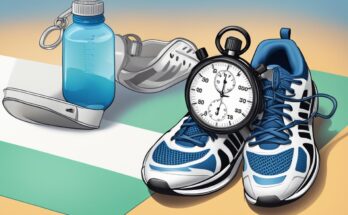Running is a popular form of exercise that is enjoyed by many people worldwide. It is an activity that requires no special equipment, and it can be done almost anywhere. But what makes running so fun? The answer to this question is not as straightforward as one might think, as different people find different aspects of running enjoyable. However, there are several reasons why running can be considered a fun and rewarding activity.
For starters, running is known to release endorphins, which are feel-good chemicals that can improve mood and reduce stress. This is one reason why many runners report feeling a sense of euphoria or “runner’s high” during or after a run. Additionally, running can be a great way to challenge oneself and achieve personal goals. Whether it’s running a certain distance or improving one’s pace, the sense of accomplishment that comes with reaching these goals can be incredibly satisfying. Finally, running can be a social activity, as many people enjoy running with friends or participating in races and events with other runners.
The Physical Benefits of Running
Running is not only a fun activity but also a great way to improve physical health. Here are some of the physical benefits of running:
Cardiovascular Health
Running is an excellent form of aerobic exercise that can help improve cardiovascular health. It helps to strengthen the heart and lungs, which can reduce the risk of cardiovascular disease. Running regularly can also lower resting heart rate, improve blood circulation, and increase the oxygen-carrying capacity of the blood.
Bone Density
Running is a weight-bearing exercise that can help improve bone density. As the feet and legs bear the weight of the body, the bones become stronger and more dense. This can help reduce the risk of osteoporosis and fractures.
Weight Loss
Running can also help with weight loss. It is a high-intensity exercise that burns a lot of calories. The more you run, the more calories you burn, which can help you lose weight and maintain a healthy weight.
In addition to these benefits, running can also improve overall fitness, increase endurance, and boost the immune system. However, it is important to remember to rest and recover properly to avoid injury and burnout.
When running, it is important to wear proper shoes and clothing to prevent injury and discomfort. Trail running and marathons are popular among athletes and running enthusiasts, but it is important to train properly and listen to your body to avoid overexertion.
Overall, running is a great form of exercise that can improve physical health and fitness.
The Mental Benefits of Running
Regular running can have a significant impact on mental health and cognitive function. In this section, we will explore some of the most notable mental benefits of running.
Mood and Confidence
Running has been shown to improve mood and increase confidence levels. It is believed that this is due to the release of endorphins, which are natural painkillers that can produce feelings of euphoria. Additionally, running can provide a sense of accomplishment and help individuals set and achieve goals, which can boost self-esteem and confidence.
Memory and Cognitive Function
Studies have shown that running can improve memory and cognitive function. This may be due to the increased blood flow and oxygen to the brain during exercise. Running has also been shown to increase the production of a protein called brain-derived neurotrophic factor (BDNF), which is essential for the growth and survival of brain cells.
Mental Health
Running can have a positive impact on mental health, reducing symptoms of anxiety and depression. It is believed that this is due to the release of endorphins and the reduction of stress hormones such as cortisol. Additionally, running can provide a sense of community and social support, which can help individuals feel more connected and less isolated.
Overall, running can greatly improve the quality of life for individuals. It can provide joy and a sense of accomplishment, while also improving mental health and cognitive function. Incorporating running into a regular exercise plan can lead to numerous benefits for both the body and mind.
Running for Fun and Variety
Running is not only a great way to stay in shape, but it can also be a lot of fun. There are many different ways to enjoy running, and it can be a great way to add some variety to your exercise routine. Here are some ways to make running more fun and exciting:
Accessible to Everyone
One of the great things about running is that it is accessible to everyone. Whether you are a high school student looking to improve your fitness, a college athlete training for a race, or just someone looking to stay active, running can be a great option. You don’t need any special equipment or a gym membership to go for a run, and you can do it just about anywhere.
Different Types of Running
There are many different types of running, and each one offers its own unique benefits. Some people enjoy long-distance running, while others prefer sprints or interval training. Trail running can be a great way to get out into nature and explore new trails, while treadmill running can be a great option when the weather is bad. Mixing up your running routine can help keep things interesting and prevent boredom.
Setting Goals
Setting goals can be a great way to stay motivated and make running more fun. Whether you are training for a race or just trying to improve your fitness, setting goals can help you stay on track and measure your progress. You can set goals based on distance, time, or even the number of runs you do each week. Having a goal to work towards can help you stay focused and motivated.
Overall, running can be a fun and exciting way to stay active and improve your fitness. By trying different types of running, setting goals, and making it a part of your lifestyle, you can make running a fun and enjoyable activity that you look forward to each day.
Running as a Lifestyle
Running can be more than just a form of exercise. For many individuals, it becomes a lifestyle. Running as a lifestyle involves incorporating running into everyday routines and making it a part of one’s identity.
The Importance of Recovery
When running becomes a lifestyle, it is important to prioritize recovery. This includes stretching, foam rolling, and taking rest days. Recovery allows the body to repair and rebuild muscle tissue, preventing injury and improving overall performance.
Injury Prevention
Injury prevention is crucial for any runner, especially those who make running a lifestyle. Proper footwear, a gradual increase in mileage, and cross-training can all help prevent injuries. It is also important to listen to the body and address any pain or discomfort before it becomes a more serious injury.
Diet and Hydration
Diet and hydration play a significant role in a runner’s performance and overall health. A balanced diet that includes carbohydrates, protein, and healthy fats can provide the necessary energy for running. Staying hydrated before, during, and after runs is also essential for optimal performance and recovery.
Incorporating running into one’s lifestyle can have numerous benefits. It can lead to a fitter and healthier lifestyle, better sleep, and even improve mental health. However, it is important to prioritize recovery, injury prevention, and proper nutrition to ensure a sustainable and enjoyable running lifestyle.
The Social Aspect of Running
Running is not just a physical activity, it is also a social one. Many runners enjoy the social aspect of running, which can make the activity even more fun and fulfilling. In this section, we will explore some of the ways that running can be a social experience.
Running with Others
Running with others is a great way to stay motivated and make the activity more enjoyable. Whether it is a friend, family member, or running group, running with others can provide support, encouragement, and accountability. It can also be a great way to catch up with friends or spend time with loved ones while getting a workout in.
Joining a Running Community
Joining a running community can provide a sense of belonging and camaraderie. Many cities have running clubs or groups that meet regularly for runs and other activities. These communities can provide a supportive environment for runners of all levels and backgrounds. They can also be a great way to meet new people who share a common interest.
Participating in Races
Participating in races can be a social and rewarding experience. Races bring together runners from all over the world and provide an opportunity to push oneself to new limits. The London Marathon and the Boston Marathon are two of the most famous marathons in the world, attracting thousands of runners each year. Participating in a race can provide a sense of accomplishment and community.
In conclusion, the social aspect of running can make the activity even more fun and fulfilling. Whether it is running with others, joining a running community, or participating in races, there are many ways to make running a social experience.
What’s so special about running?
As one of the most vigorous exercises out there, running is an extremely effective way to burn calories and lose weight. The anxiety- and stress-relieving aspects of moderate exercise linger even after the workout, according to additional research published in Medicine and Science in Sports & Exercise, especially when there are no high expectations attached to the activity. The basic rule of weight loss is that you need to burn (through vital functions and exercise) more calories than you take in.
What are the 5 types of running?
Strides are usually done in bursts of 100-150 meters, or about 20-25 seconds, at about 90 effort, with equal rest. While there’s nothing wrong with giving your workouts some structure (as you’ll read below), many runners could benefit from removing the underlying stress of reaching a specific time or distance. This type of runner doesn’t mind the fatigue that comes with the journey and is eager to push their limits possibly in another time zone. You don’t need to run faster than your normal pace during long runs, but if you want to challenge yourself, you can increase your pace or mix in some intervals.
All of these types of runs are crucial elements to include in your weekly training program.




